Late Age Dynamic Strength of High-Volume Fly Ash Concrete with Nano-Silica and Polypropylene Fibres
Abstract
1. Introduction
2. Materials and Equipment
2.1. Components of Concrete Mixture
2.2. Samples Preparation and Curing Conditions
2.3. Laboratory Tests
2.3.1. Equipment
2.3.2. Recorded Signals of Dynamic Test
3. Results of Laboratory Tests
3.1. Static Test
3.2. Dynamic Test
3.2.1. Dynamic Compressive Strength ()
3.2.2. Critical Strain ()
3.2.3. Toughness
3.2.4. Critical Damage
3.2.5. Dynamic Increase Factor (DIF)
3.2.6. Comparison of DIF with Previous Recommended Expressions
- (a)
- In 1993, CEB [84] proposed a formula to estimate the DIF of concrete in compression within a strain rate range reached up to 300 s−1:where is static strain rate that equals to , , and is static compressive strength in MPa.
- (b)
- In 1997, Tedesco et al. [85] reported that the transition from low strain rate to higher values occurred at 63.1 s–1 as follows:
- (c)
- In 2008, Zhou and Hao [86] determined an empirical formula to predict the DIF diagrams for the concrete-like materials as follows:
4. Conclusions
- At room temperature, the PC concrete showed better static and dynamic behaviour than HVFANS concrete at curing ages of 7 and 28 days. However, the behaviour of HVFANS concrete was significantly improved at a curing age of 90 days and recorded superior performance than PC during the static and dynamic tests.
- At elevated temperatures, the dynamic strength of HVFANS concrete exceeded the PC at all the studied curing ages. The maximum differences between both concretes were noted at 700 °C by 59.59%, 36.68% and 43.59% at curing ages of 7, 28 and 90, respectively. Accordingly, the HVFANS concrete recorded lower strain values than PC within a maximum difference of 43.56% at a strain rate above 100 s−1.
- The formulas were suggested to estimate the dynamic increase factors of PC and HVFANS concrete at a curing age between 7 and 90 days under temperatures range of 25 to 700 °C subjected to strain rates reached up to 102.48 s−1.
- The CEB expression was more accurate to estimate the DIF of HVFANS concrete at different curing age within room temperature as well as at elevated temperatures of 400 and 700 °C at curing ages of 28 and 90 days, respectively. While the proposed expression by Zhou and Hao was more appropriate to determine the DIF of HVFANS concrete at a curing age of seven under 400 and 700 °C.
Author Contributions
Funding
Conflicts of Interest
References
- Guo, X.; Shi, H.; Dick, W.A. Compressive strength and microstructural characteristics of class C fly ash geopolymer. Cem. Concr. Compos. 2010, 32, 142–147. [Google Scholar] [CrossRef]
- Rehan, R.; Nehdi, M. Carbon dioxide emissions and climate change: Policy implications for the cement industry. Environ. Sci. Policy. 2005, 8, 105–114. [Google Scholar] [CrossRef]
- Bakharev, T. Geopolymeric materials prepared using class F fly ash and elevated temperature curing. Cem. Concr. Res. 2005, 35, 1224–1232. [Google Scholar] [CrossRef]
- Fernández-Jiménez, A.; Palomo, A.; Criado, M. Microstructure development of alkali-activated fly ash cement: A descriptive model. Cem. Concr. Res. 2005, 35, 1204–1209. [Google Scholar] [CrossRef]
- Jaturapitakkul, C.; Kiattikomol, K.; Sata, V.; Leekeeratikul, T. Use of ground coarse fly ash as a replacement of condensed silica fume in producing high-strength concrete. Cem. Concr. Res. 2004, 34, 549–555. [Google Scholar] [CrossRef]
- Jiang, L.; Guan, Y. Pore structure and its effect on strength of high-volume fly ash paste. Cem. Concr. Res. 1999, 29, 631–633. [Google Scholar] [CrossRef]
- Montgomery, D.; Hughes, D.; Williams, R. Fly ash in concrete—A microstructure study. Cem. Concr. Res. 1981, 11, 591–603. [Google Scholar] [CrossRef]
- Li, G. Properties of high-volume fly ash concrete incorporating nano-SiO2. Cem. Concr. Res. 2004, 34, 1043–1049. [Google Scholar] [CrossRef]
- Zhang, M.H.; Islam, J. Use of nano-silica to reduce setting time and increase early strength of concretes with high volumes of fly ash or slag. Constr. Build. Mater. 2012, 29, 573–580. [Google Scholar] [CrossRef]
- Ibrahim, R.K. The Strength and Micro Structures of Sustainable High Strength High-Volume Fly Ash Concrete with Nano Materials Exposed to High Temperature. Ph.D. Thesis, Universiti Kebangsaan Malaysia (UKM), Bangi, Malaysia, 2013. [Google Scholar]
- Ibrahim, R.K.; Hamid, R.; Taha, M.R. Fire resistance of high-volume fly ash mortars with nanosilica addition. Constr. Build. Mater. 2012, 36, 779–786. [Google Scholar] [CrossRef]
- Mussa, M.H.; Mutalib, A.A.; Hamid, R.; Naidu, S.R.; Radzi, N.A.M.; Abedini, M. Assessment of damage to an underground box tunnel by a surface explosion. Tunn. Undergr. Space Technol. 2017, 66, 64–76. [Google Scholar] [CrossRef]
- Mussa, M.H.; Mutalib, A.A.; Hamid, R.; Raman, S.N. Blast damage assessment of symmetrical box–shaped underground tunnel according to peak particle velocity (PPV) and single degree of freedom (SDOF) criteria. Symmetry 2018, 10, 158. [Google Scholar] [CrossRef]
- Abedini, M.; Mutalib, A.A.; Raman, S.N.; Akhlaghi, E.; Mussa, M.H.; Ansari, M. Numerical investigation on the non-linear response of reinforced concrete (RC) columns subjected to extreme dynamic loads. J. Asian Sci. Res. 2017, 7, 86. [Google Scholar] [CrossRef][Green Version]
- Saadun, A.; Mutalib, A.A.; Hamid, R.; Mussa, M.H. Behaviour of polypropylene fiber reinforced concrete under dynamic impact load. J. Eng. Sci. Technol. 2016, 11, 684–693. [Google Scholar]
- Abedini, M.; Mutalib, A.A.; Mehrmashhadi, J.; Raman, S.N.; Alipour, R.; Momeni, T.; Mussa, M.H. Large Deflection Behavior Effect in Reinforced Concrete Columns Exposed to Extreme Dynamic Loads. 2019. Available online: https://engrxiv.org/6n5fs/ (accessed on 25 July 2019).
- Abedini, M.; Khlaghi, E.A.; Mehrmashhadi, J.; Mussa, M.H.; Ansari, M.; Momeni, T. Evaluation of concrete structures reinforced with fiber reinforced polymers bars: A review. J. Asian Sci. Res. 2017, 7, 165. [Google Scholar] [CrossRef]
- Mutalib, A.A.; Mussa, M.H.; Hao, H. Effect of CFRP strengthening properties with anchoring systems on PI diagrams of RC panels under blast loads. Constr. Build. Mater. 2019, 200, 648–663. [Google Scholar] [CrossRef]
- Abbood, I.S.; Mahmod, M.; Hanoon, A.N.; Jaafar, M.S.; Mussa, M.H. Seismic response analysis of linked twin tall buildings with structural coupling. Int. J. Civ. Eng. Technol. 2018, 9, 208–219. [Google Scholar]
- Ziyan, L.; Yuzhuo, G.W.G. Dynamic compression behavior of heated concrete. China Civ. Eng. J. 2011, 4, 013. [Google Scholar]
- Huo, J.S.; He, Y.M.; Xiao, L.P.; Chen, B.S. Experimental study on dynamic behaviours of concrete after exposure to high temperatures up to 700 °C. Mater. Struct. 2013, 46, 255–265. [Google Scholar] [CrossRef]
- Huo, J.; Wang, P.; Yu, Q.; He, Y. Dynamic behaviour of normal-strength carbonate aggregate concrete at temperatures up to 800 °C. Mag. Concr. Res. 2014, 66, 975–990. [Google Scholar] [CrossRef]
- He, Y.; Huo, J.; Xiao, Y. Experimental study on dynamic behavior of concrete at elevated temperatures. Adv. Sci. Lett. 2011, 4, 1128–1131. [Google Scholar] [CrossRef]
- Zhai, C.; Chen, L.; Fang, Q.; Chen, W.; Jiang, X. Experimental study of strain rate effects on normal weight concrete after exposure to elevated temperature. Mater. Struct. 2017, 50, 40. [Google Scholar] [CrossRef]
- Mussa, M.H.; Mutalib, A.A. Effect of geometric parameters (β and τ) on behaviour of cold formed stainless steel tubular X-joints. Int. J. Steel Struct. 2018, 18, 821–830. [Google Scholar] [CrossRef]
- Chen, L.; Fang, Q.; Jiang, X.; Ruan, Z.; Hong, J. Combined effects of high temperature and high strain rate on normal weight concrete. Int. J. Impact Eng. 2015, 86, 40–56. [Google Scholar] [CrossRef]
- Li, Z.; Xu, J.; Bai, E. Static and dynamic mechanical properties of concrete after high temperature exposure. Mater. Sci. Eng. A 2012, 544, 27–32. [Google Scholar] [CrossRef]
- Su, H.; Xu, J.; Ren, W. Experimental study on the dynamic compressive mechanical properties of concrete at elevated temperature. Mater. Des. 2014, 56, 579–588. [Google Scholar] [CrossRef]
- Committee, A. Guide for Selecting Proportions for High-Strength Concrete with Portland Cement & Fly ASH-ACI 211.4 R-93; American Concrete Institute: Farming-ton Hills, MI, USA, 1998. [Google Scholar]
- Standard, M. Portland Cement (Ordinary and Rapid-Hardening): Part 1, 2nd ed.; MS: Bangi, Malaysia, 2003; p. 522. [Google Scholar]
- Standard, B. Fly ASH for Concrete—Part 1: Definition, Specifications and Conformity Criteria; European Committee for Standardization: Brussels, Belgium, 2005. [Google Scholar]
- Standard, A. C136 Standard Test Method for Sieve Analysis of Fine and Coarse Aggregates; ASTM International: West Conshohocken, PA, USA, 2006. [Google Scholar]
- ASTM, A. C128-07a Standard Test Method for Density, Relative Density (Specific Gravity), and Absorption of Fine Aggregate; ASTM International: West Conshohocken, PA, USA, 2007. [Google Scholar]
- ASTM, C. Standard Test Method for Bulk Density (“Unit Weight”) and Voids in Aggregate; American Society for Testing and Materials, Annual Book: West Conshohocken, PA, USA, 2009. [Google Scholar]
- Nishida, A. Study in the Properties of High Strength Concrete with Short Polypropylene Fiber for Spalling Reasistance, Concrete under Severe Condetions. In Proceedings of the International Conference on Concrete under Severe Conditions, Sapporo, Japan, 2–4 August 1995; Volume 2, pp. 1141–1150. [Google Scholar]
- Kalifa, P.; Chene, G.; Galle, C. High-temperature behaviour of HPC with polypropylene fibres: From spalling to microstructure. Cem. Concr. Res. 2001, 31, 1487–1499. [Google Scholar] [CrossRef]
- Noumowe, A. Mechanical properties and microstructure of high strength concrete containing polypropylene fibres exposed to temperatures up to 200 °C. Cem. Concr. Res. 2005, 35, 2192–2198. [Google Scholar] [CrossRef]
- Zeiml, M.; Leithner, D.; Lackner, R.; Mang, H.A. How do polypropylene fibers improve the spalling behavior of in-situ concrete? Cem. Concr. Res. 2006, 36, 929–942. [Google Scholar] [CrossRef]
- Bilodeau, A.; Kodur, V.; Hoff, G. Optimization of the type and amount of polypropylene fibres for preventing the spalling of lightweight concrete subjected to hydrocarbon fire. Cem. Concr. Compos. 2004, 26, 163–174. [Google Scholar] [CrossRef]
- Mutalib, A.A.; Mussa, M.; Mohd Taib, A. Behaviour of prestressed box beam strengthened with CFRP under effect of strand snapping. Gradevinar 2020, 72, 103–113. [Google Scholar]
- Standard, A. C192 Standard Practice for Making and Curing Concrete Test Specimens in the Laboratory (ASTM C192-07); ASTM International: West Conshohocken, PA, USA, 2007. [Google Scholar]
- Neville, A.M. Properties of Concrete; Longman Publisher: London, UK, 1995. [Google Scholar]
- ASTM, C. 1602/C 1602M-12 Standard Specification for Mixing Water Used in the Hydraulic Cement Concrete; ASTM International: West Conshohocken, PA, USA, 2012. [Google Scholar]
- Standard, M.J. Thermal Insulation—Determination of Steady-State Thermal Resistance and Related Properties—Guarded Hot Plate Apparatus (ISO 8302: 1991, IDT); Department of Standards Malaysia: Cyberjaya, Malaysia, 2003.
- EN, B. Testing Hardened Concret—Part 3: Compressive Strength of Test Specimens. Available online: http://home.aktor.qa/External%20Documents/Intenational%20Specifications/British%20Standards/BS%20EN/BS%20EN%2012390-3-2009.pdf (accessed on 31 May 2009).
- Al-Masoodi, A.H.H.; Kawan, A.; Kasmuri, M.; Hamid, R.; Khan, M.N.N. Static and dynamic properties of concrete with different types and shapes of fibrous reinforcement. Constr. Build. Mater. 2016, 104, 247–262. [Google Scholar] [CrossRef]
- Chien Yet, T.; Hamid, R.; Kasmuri, M. Dynamic stress-strain behaviour of steel fiber reinforced high-performance concrete with fly ash. Adv. Civ. Eng. 2012, 2012, 907431. [Google Scholar] [CrossRef]
- Davies, E.; Hunter, S. The dynamic compression testing of solids by the method of the split Hopkinson pressure bar. J. Mech. Phys. Solids. 1963, 11, 155–179. [Google Scholar] [CrossRef]
- Lindholm, U.S. High strain rate tests. Meas. Mech. Prop. 1971, 5, 199–271. [Google Scholar]
- Kirby, M.S.P. Designing a Data Acquisition System for a Split Hopkinson Pressure Bar. Available online: https://pdfs.semanticscholar.org/36d6/e475d65a484381a88dfb064e8d99b8d389b5.pdf (accessed on 14 June 2015).
- Dyab, M.M. Providing Learning Opportunities by Designing a Split Hopkinson Pressure Bar. Age 2013, 23, 1. [Google Scholar]
- Lok, T.; Zhao, P.; Lu, G. Using the split Hopkinson pressure bar to investigate the dynamic behaviour of SFRC. Mag. Concr. Res. 2003, 55, 183–191. [Google Scholar] [CrossRef]
- Lu, Y.; Li, Q. Appraisal of pulse-shaping technique in split Hopkinson pressure bar tests for brittle materials. Int. J. Prot. Struct. 2010, 1, 363–390. [Google Scholar] [CrossRef]
- Mussa, M.H.; Mutalib, A.A.; Hamid, R.; Raman, S.N. Dynamic properties of high volume fly ash nanosilica (HVFANS) concrete subjected to combined effect of high strain rate and temperature. Lat. Am. J. Solids Struct. 2018, 15. [Google Scholar] [CrossRef]
- Berndt, M. Properties of sustainable concrete containing fly ash, slag and recycled concrete aggregate. Constr. Build. Mater. 2009, 23, 2606–2613. [Google Scholar] [CrossRef]
- Ji, T. Preliminary study on the water permeability and microstructure of concrete incorporating nano-SiO2. Cem. Concr. Res. 2005, 35, 1943–1947. [Google Scholar] [CrossRef]
- Institutions, B.S. Method for Determination of Compressive Strength of Concrete Cubes; BS: London, UK, 1881. [Google Scholar]
- Miller, O.; Freund, L.; Needleman, A. Modeling and simulation of dynamic fragmentation in brittle materials. Int. J. Fract. 1999, 96, 101–125. [Google Scholar] [CrossRef]
- Cadoni, E.; Fenu, L.; Forni, D. Strain rate behaviour in tension of austenitic stainless steel used for reinforcing bars. Constr. Build. Mater. 2012, 35, 399–407. [Google Scholar] [CrossRef]
- Johnstone, C.; Ruiz, C. Dynamic testing of ceramics under tensile stress. Int. J. Solids Struct. 1995, 32, 2647–2656. [Google Scholar] [CrossRef]
- Lee, O.; Kim, G.H. Thickness effects on mechanical behavior of a composite material (1001P) and polycarbonate in split Hopkinson pressure bar technique. J. Mater. Sci. Lett. 2000, 19, 1805–1808. [Google Scholar] [CrossRef]
- Zhao, J.; Li, H. Experimental determination of dynamic tensile properties of a granite. Int. J. Rock Mech. Min. Sci. 2000, 37, 861–866. [Google Scholar] [CrossRef]
- Cadoni, E. Dynamic characterization of orthogneiss rock subjected to intermediate and high strain rates in tension. Rock Mech. Rock Eng. 2010, 43, 667–676. [Google Scholar] [CrossRef]
- Grady, D.E.; Kipp, M.E. The micromechanics of impact fracture of rock. In International Journal of Rock Mechanics and Mining Sciences & Geomechanics Abstracts; Elsevier: Amsterdam, The Netherlands, 1979. [Google Scholar]
- Ross, C.A.; Jerome, D.M.; Tedesco, J.W.; Hughes, M.L. Moisture and strain rate effects on concrete strength. Mater. J. 1996, 93, 293–300. [Google Scholar]
- Bischoff, P.; Perry, S. Compressive behaviour of concrete at high strain rates. Mater. Struct. 1991, 24, 425–450. [Google Scholar] [CrossRef]
- Lai, J.; Sun, W. Dynamic behaviour and visco-elastic damage model of ultra-high performance cementitious composite. Cem. Concr. Res. 2009, 39, 1044–1051. [Google Scholar] [CrossRef]
- Köksal, F.; Altun, F.; Yiğit, İ.; Şahin, Y. Combined effect of silica fume and steel fiber on the mechanical properties of high strength concretes. Constr. Build. Mater. 2008, 22, 1874–1880. [Google Scholar] [CrossRef]
- Shannag, M. High strength concrete containing natural pozzolan and silica fume. Cem. Concr. Compos. 2000, 22, 399–406. [Google Scholar] [CrossRef]
- Nili, M.; Afroughsabet, V. The effects of silica fume and polypropylene fibers on the impact resistance and mechanical properties of concrete. Constr. Build. Mater. 2010, 24, 927–933. [Google Scholar] [CrossRef]
- Li, W.; Xu, J. Mechanical properties of basalt fiber reinforced geopolymeric concrete under impact loading. Mater. Sci. Eng. A 2009, 505, 178–186. [Google Scholar] [CrossRef]
- Li, W.; Xu, J. Impact characterization of basalt fiber reinforced geopolymeric concrete using a 100-mm-diameter split Hopkinson pressure bar. Mater. Sci. Eng. A 2009, 513, 145–153. [Google Scholar] [CrossRef]
- Wang, S.; Zhang, M.-H.; Quek, S.T. Effect of specimen size on static strength and dynamic increase factor of high-strength concrete from SHPB test. J. Test. Eval. 2011, 39, 1–10. [Google Scholar]
- Clayton, J.D. A model for deformation and fragmentation in crushable brittle solids. Int. J. Impact Eng. 2008, 35, 269–289. [Google Scholar] [CrossRef]
- Wang, Z.L.; Liu, Y.; Shen, R. Stress—Strain relationship of steel fiber-reinforced concrete under dynamic compression. Constr. Build. Mater. 2008, 22, 811–819. [Google Scholar] [CrossRef]
- Hamdi, E.; Romdhane, N.B.; le Cléac’h, J.M. A tensile damage model for rocks: Application to blast induced damage assessment. Comput. Geotech. 2011, 38, 133–141. [Google Scholar] [CrossRef]
- Addessio, F.L.; Johnson, J.N. A constitutive model for the dynamic response of brittle materials. J. Appl. Phys. 1990, 67, 3275–3286. [Google Scholar] [CrossRef]
- Wang, Z.L.; Li, Y.C.; Wang, J. A damage-softening statistical constitutive model considering rock residual strength. Comput. Geosci. 2007, 33, 1–9. [Google Scholar] [CrossRef]
- Vaughn, N.; Polnaszek, C. Design-Expert® Software; Stat-Ease, Inc.: Minneapolis, MN, USA, 2007. [Google Scholar]
- Joglekar, A.; May, A. Product excellence through design of experiments. Cereal Foods World 1987, 32, 857. [Google Scholar]
- Noordin, M.Y.; Venkatesh, V.C.; Sharif, S.; Elting, S.; Abdullah, A. Application of response surface methodology in describing the performance of coated carbide tools when turning AISI 1045 steel. J. Mater. Process. Technol. 2004, 145, 46–58. [Google Scholar] [CrossRef]
- Montgomery, D.C. Design and Analysis of Experiments 6th Edition with Design Expert Software; John Wiley & Sons: Hoboken, NJ, USA, 2004. [Google Scholar]
- Malvar, L.J.; Ross, C.A. Review of strain rate effects for concrete in tension. Mater. J. 1998, 95, 735–739. [Google Scholar]
- MC90, C. Design of Concrete Structures. CEB-FIP Model Code 1990; Thomas, T., Ed.; British Standard Institution: London, UK, 1993. [Google Scholar]
- Tedesco, J.W.; Powell, J.C.; Ross, C.A.; Hughes, M.L. A strain-rate-dependent concrete material model for ADINA. Comput. Struct. 1997, 64, 1053–1067. [Google Scholar] [CrossRef]
- Zhou, X.; Hao, H. Modelling of compressive behaviour of concrete-like materials at high strain rate. Int. J. Solids Struct. 2008, 45, 4648–4661. [Google Scholar] [CrossRef]
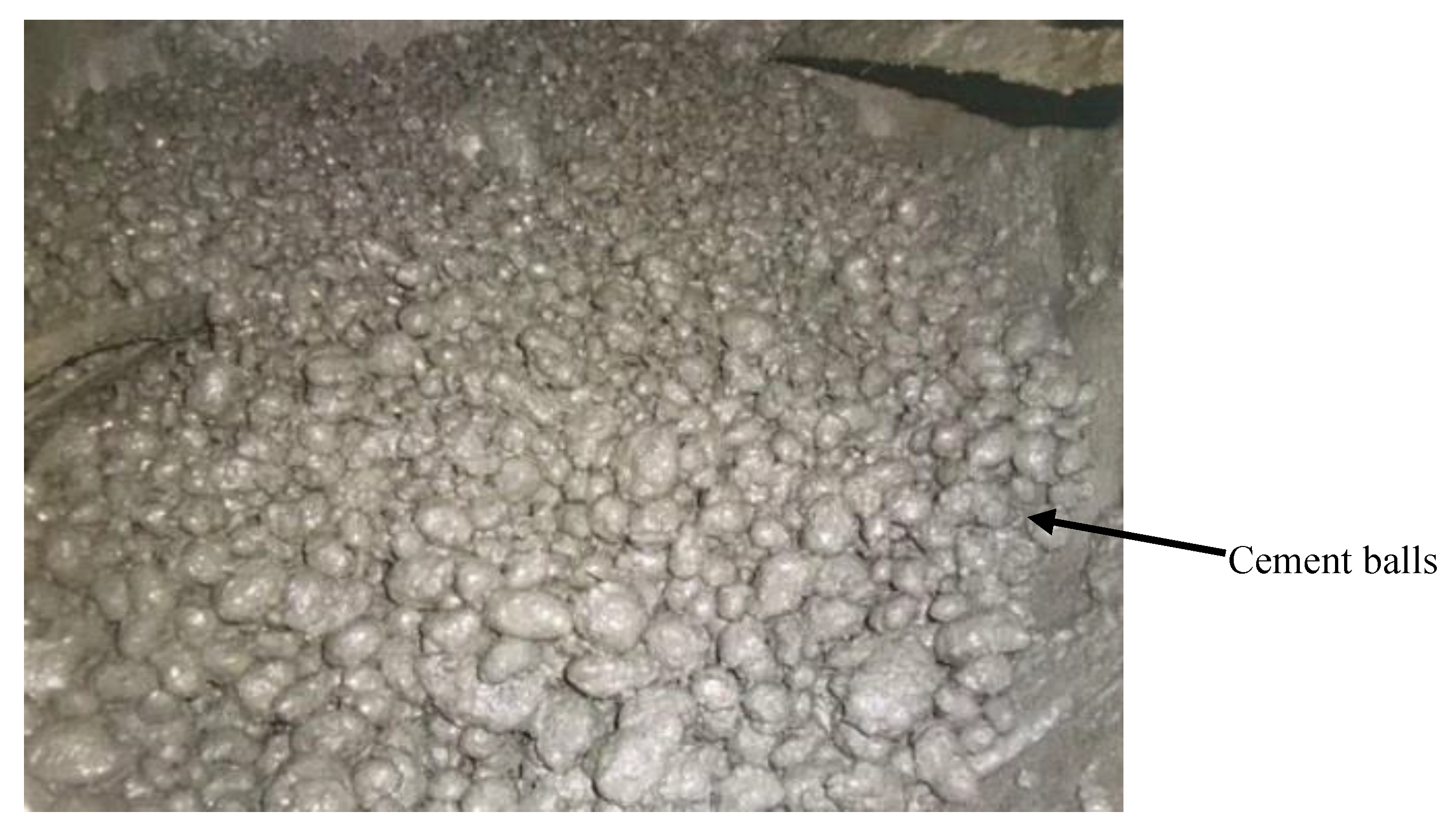
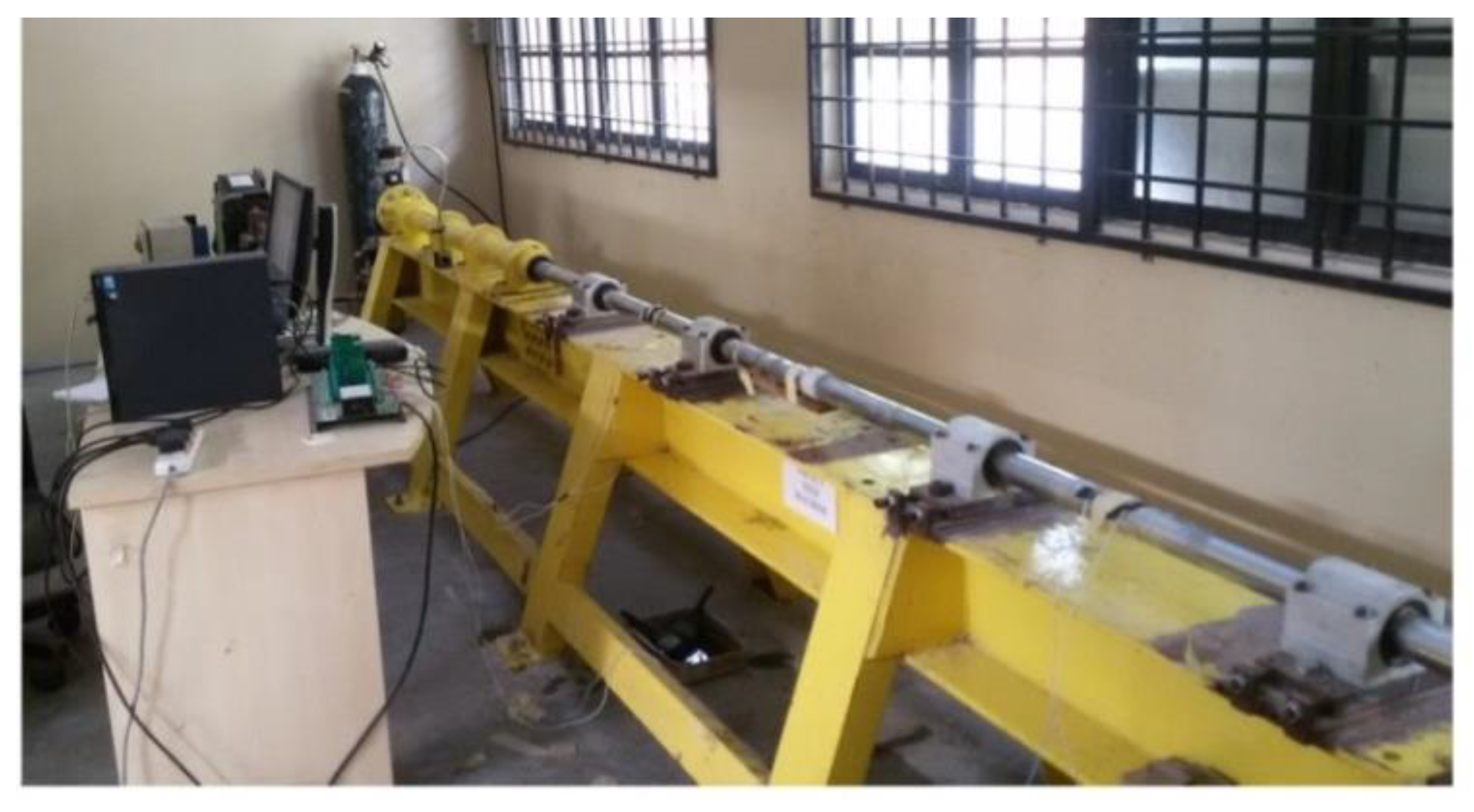
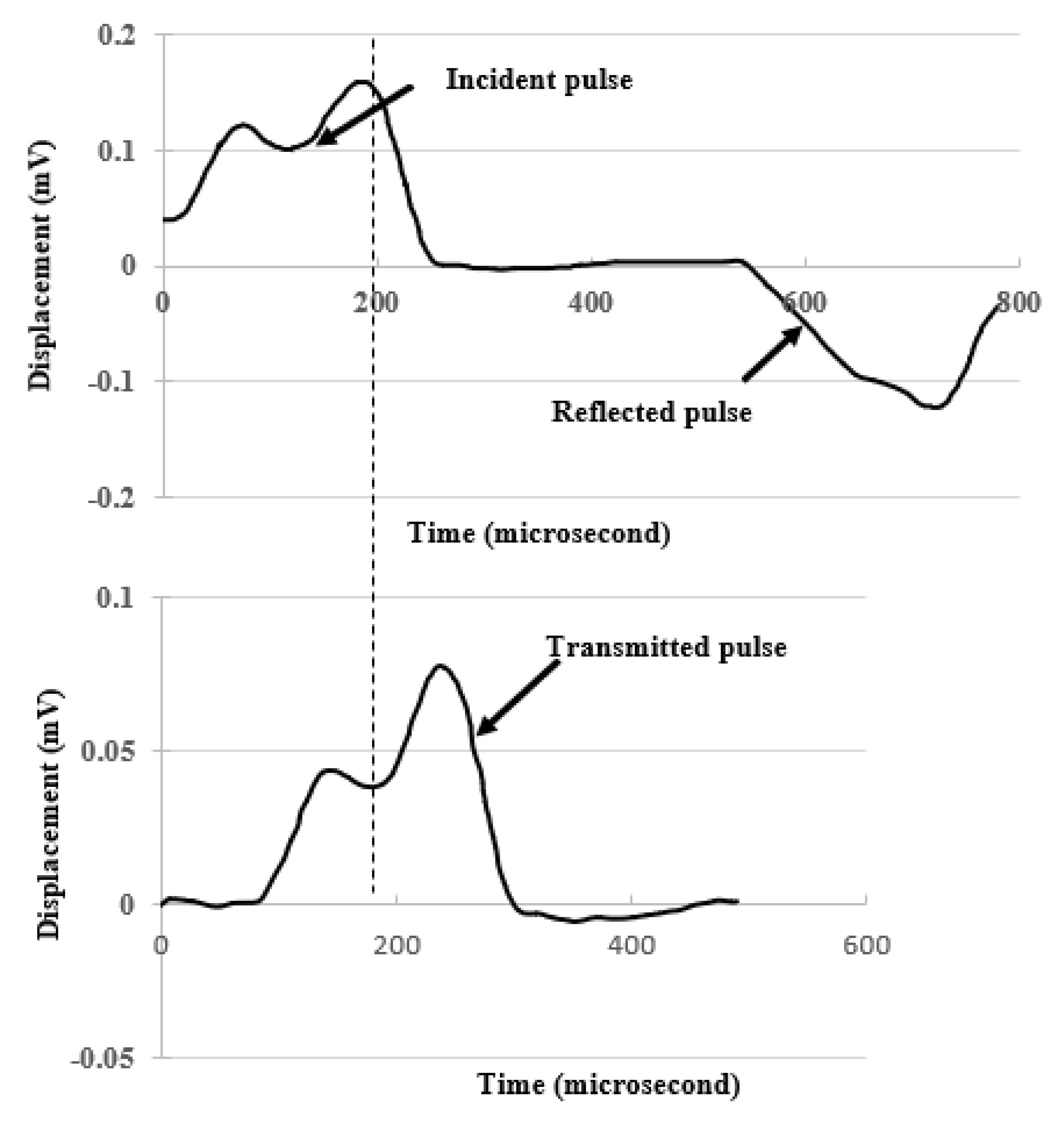


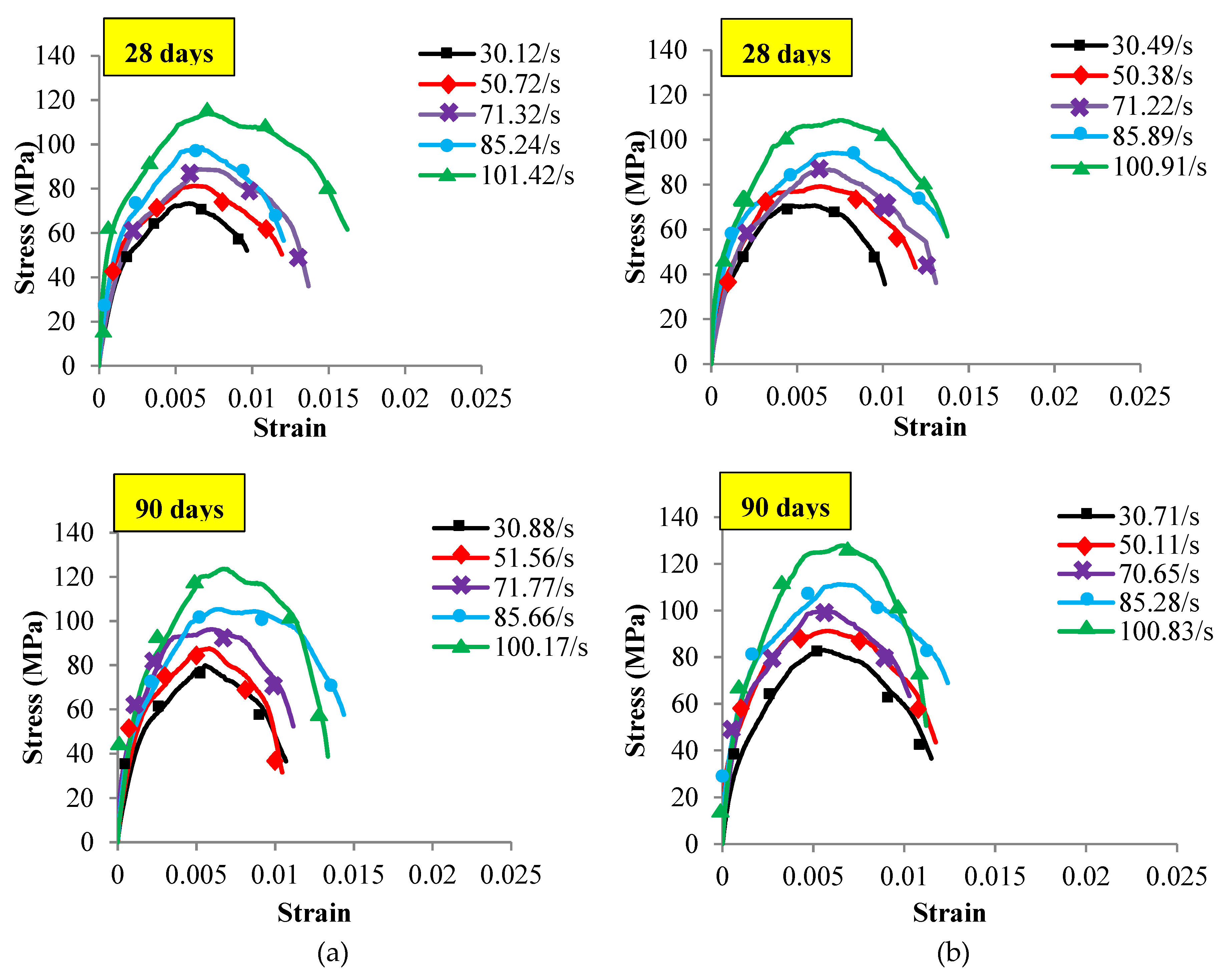
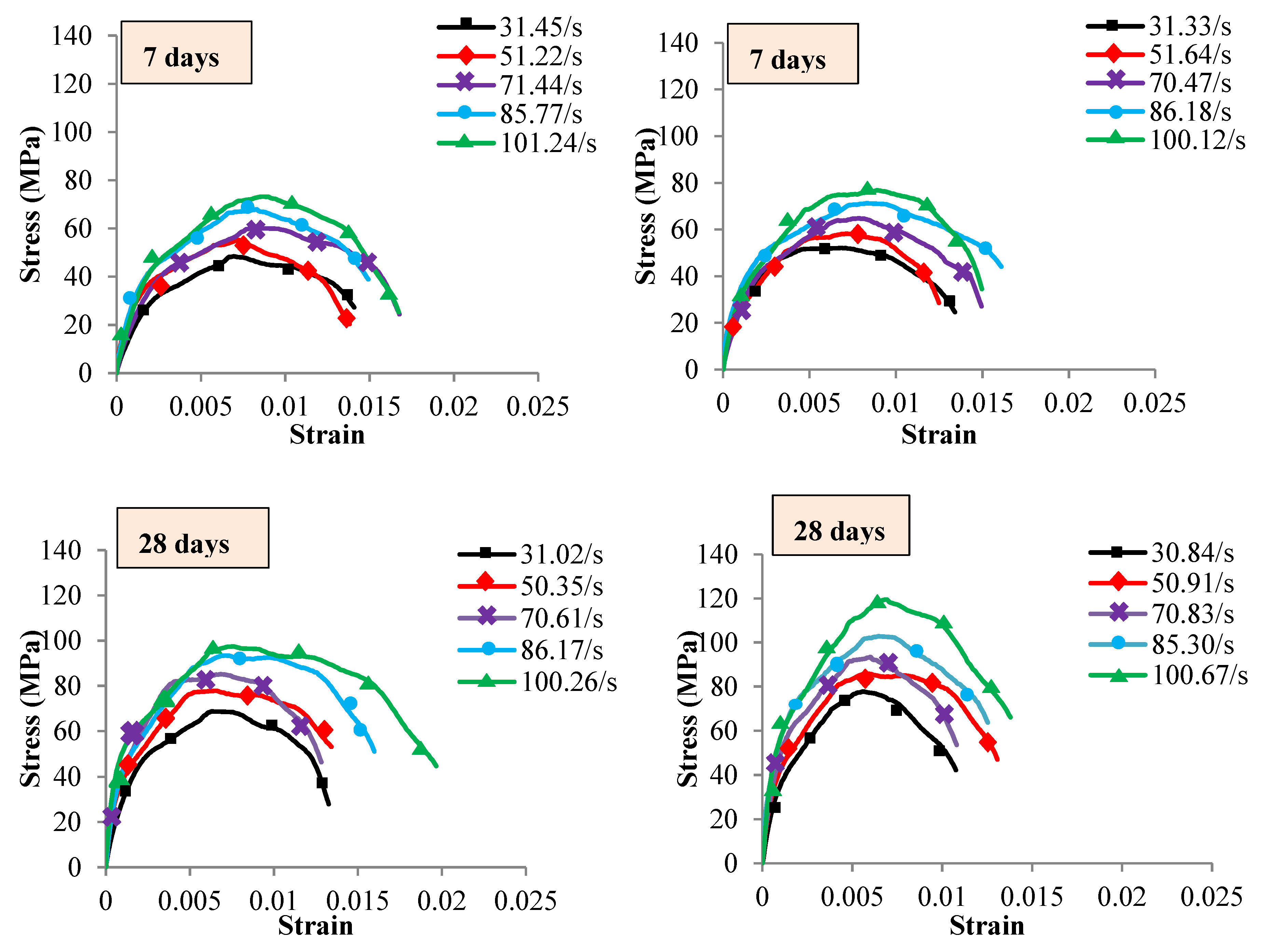
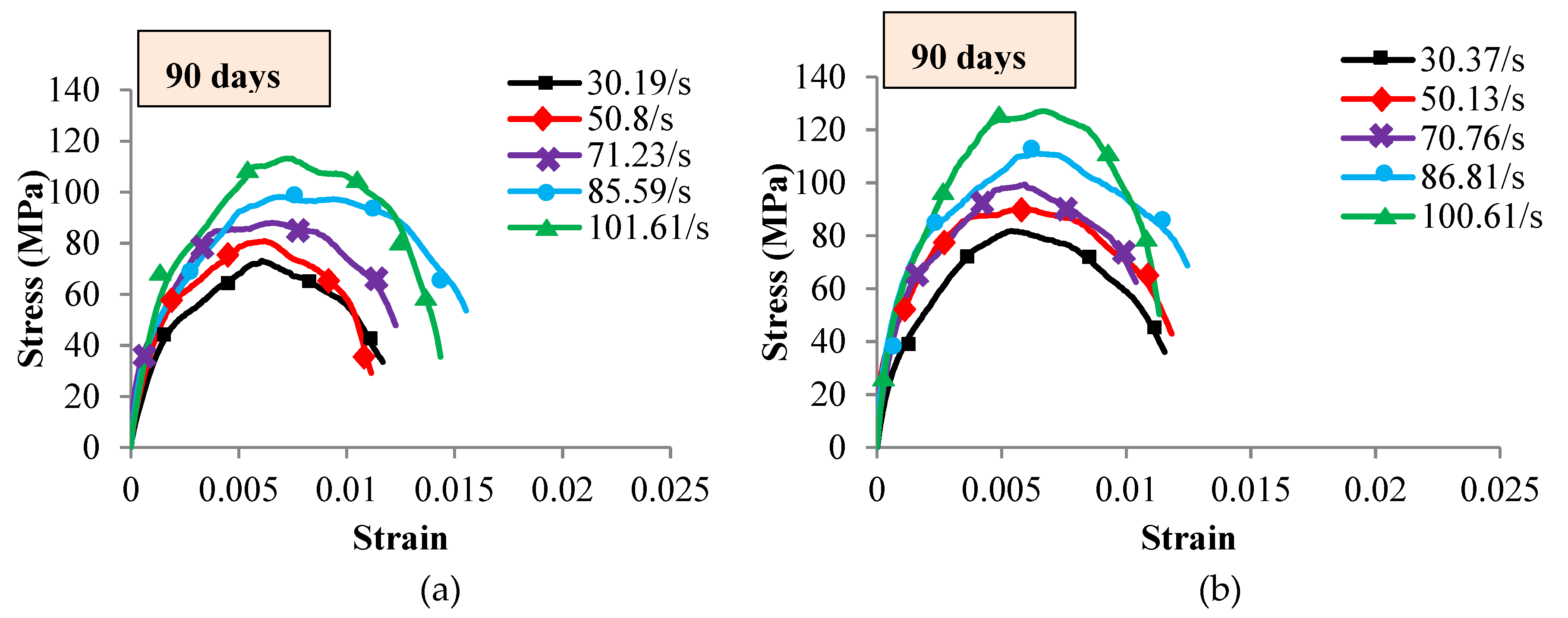

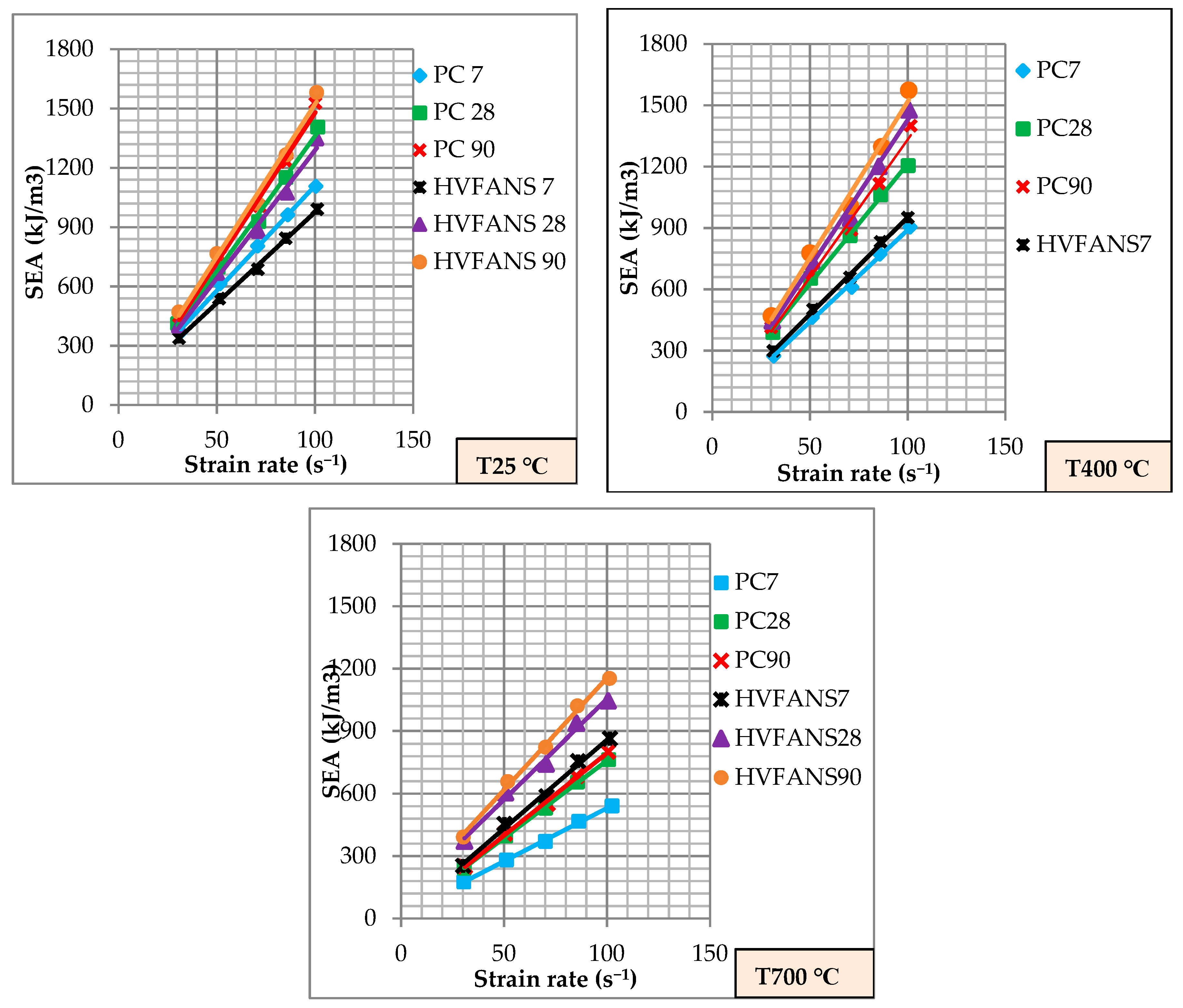
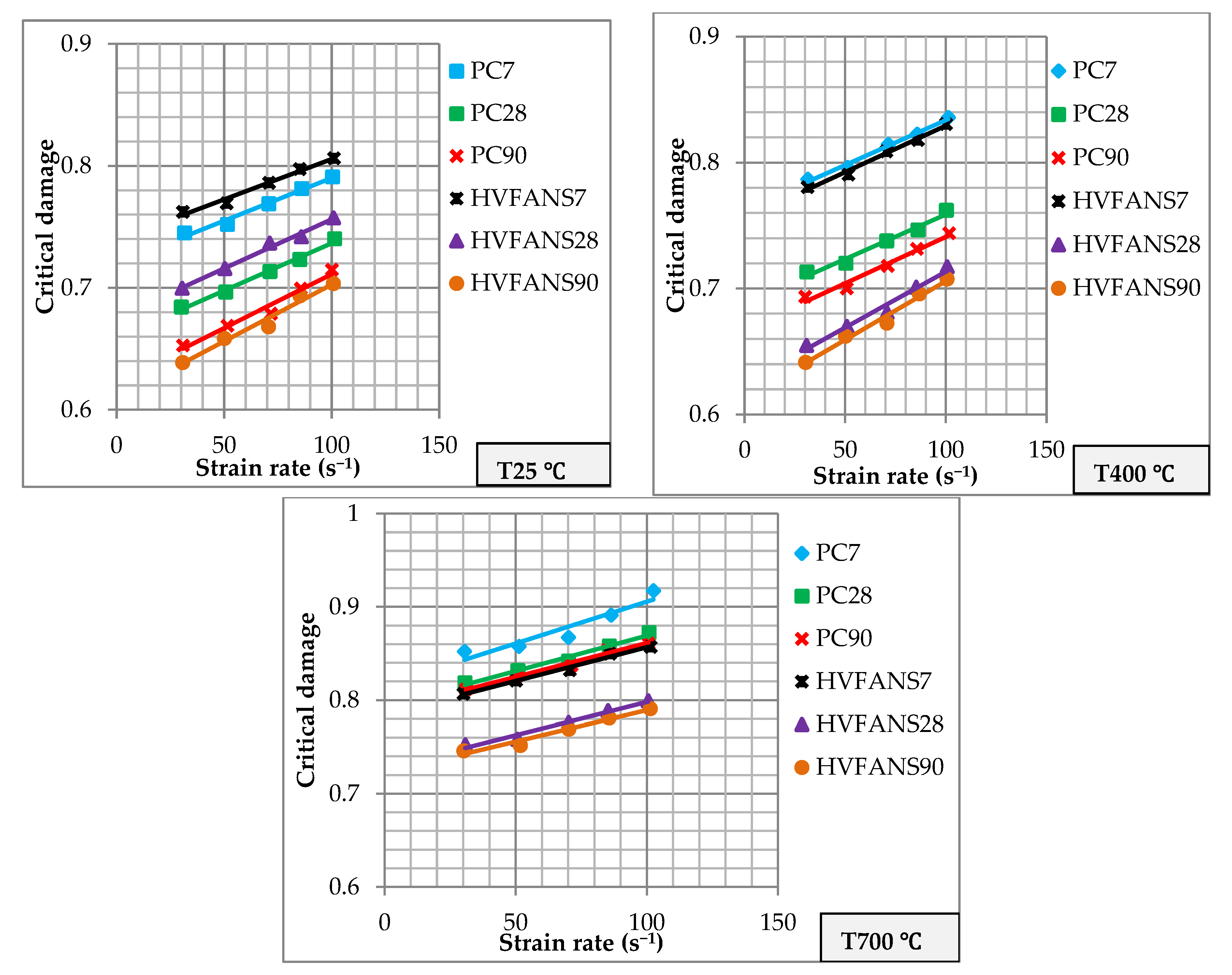
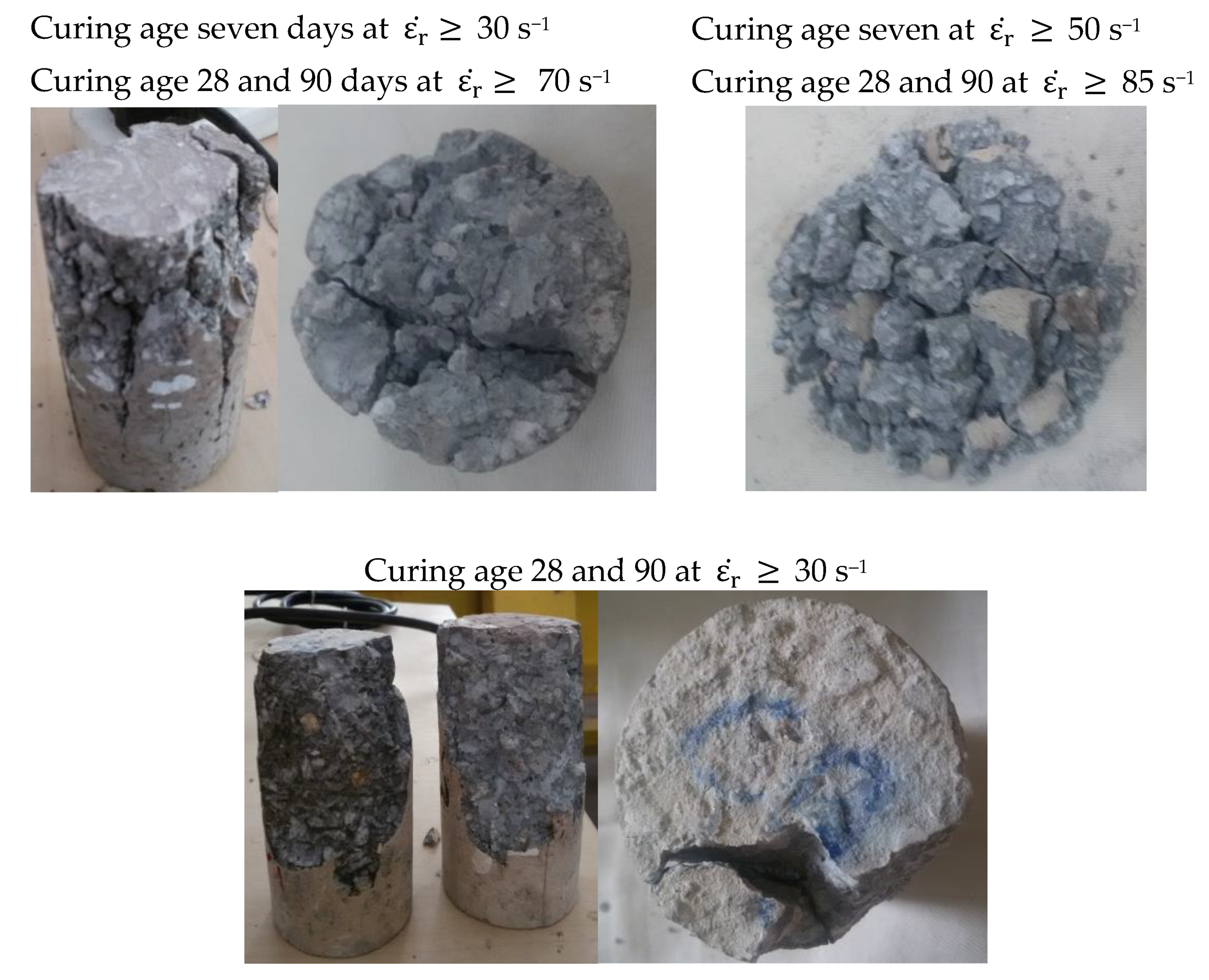
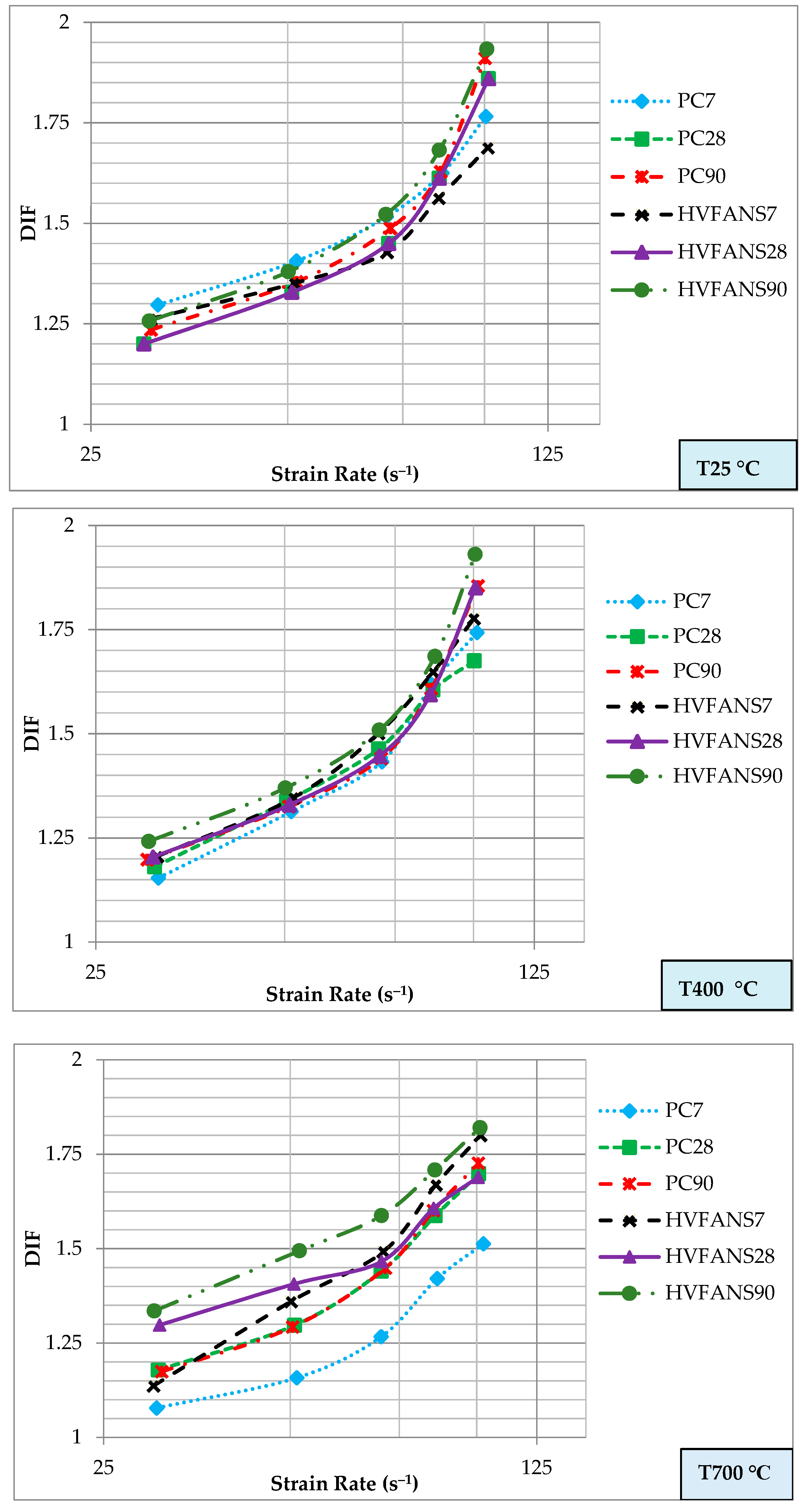
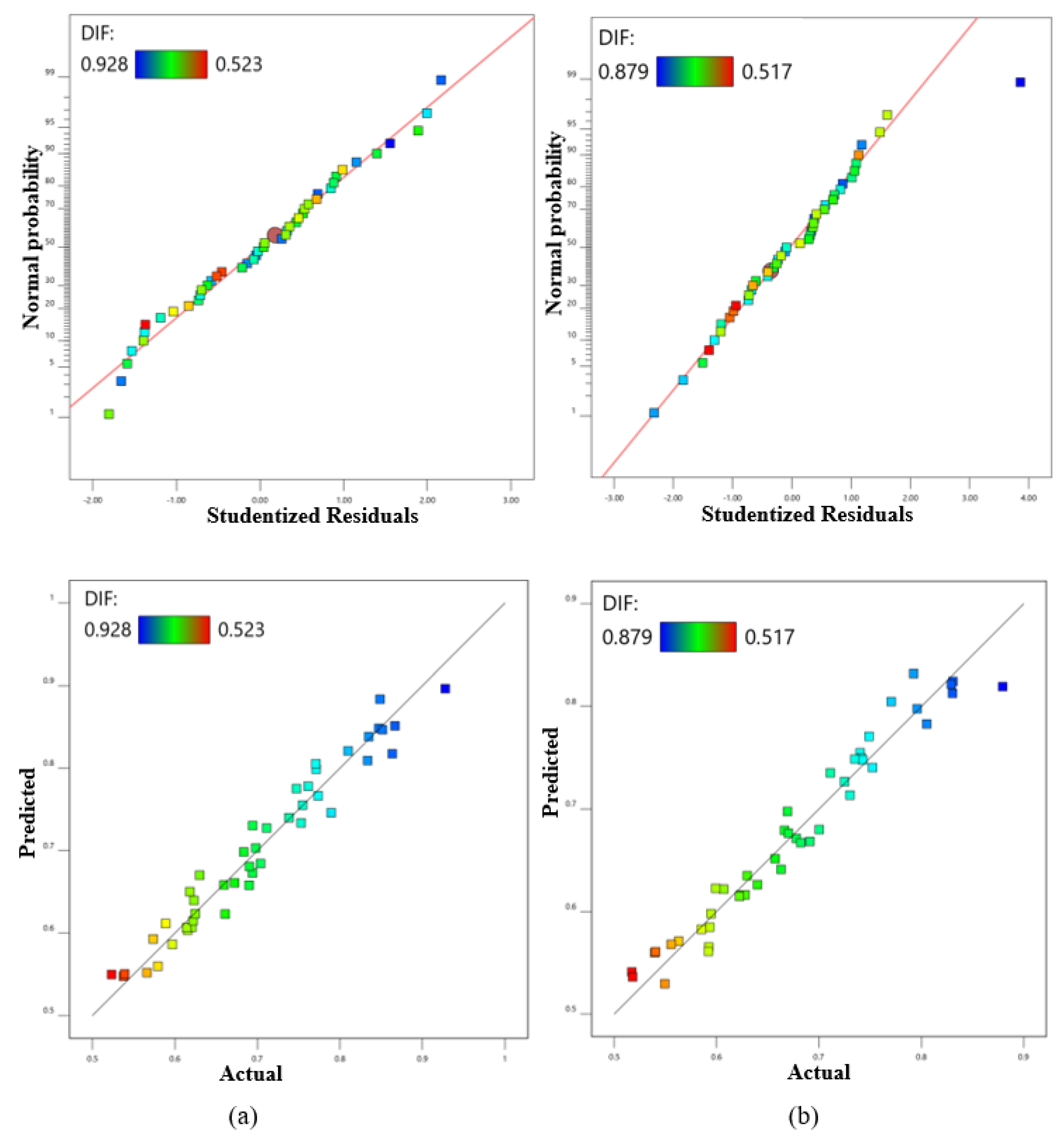
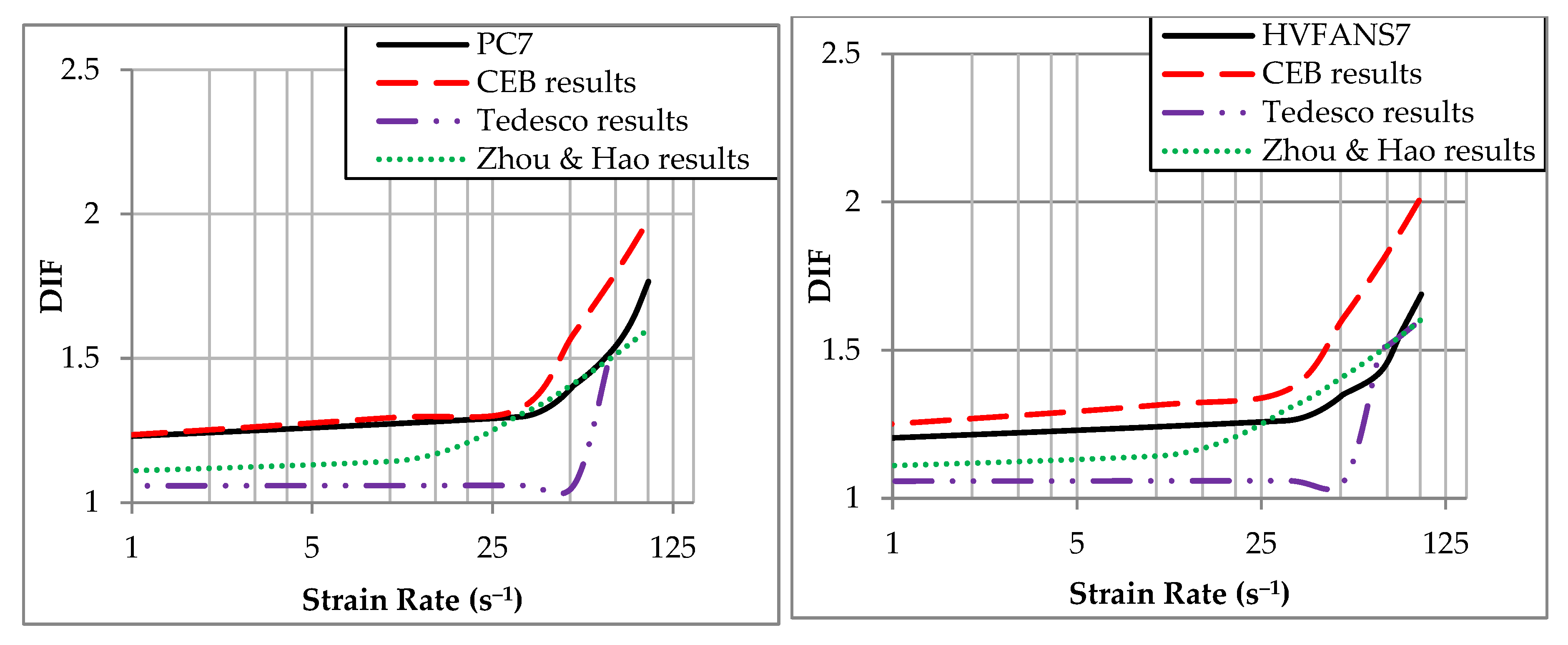


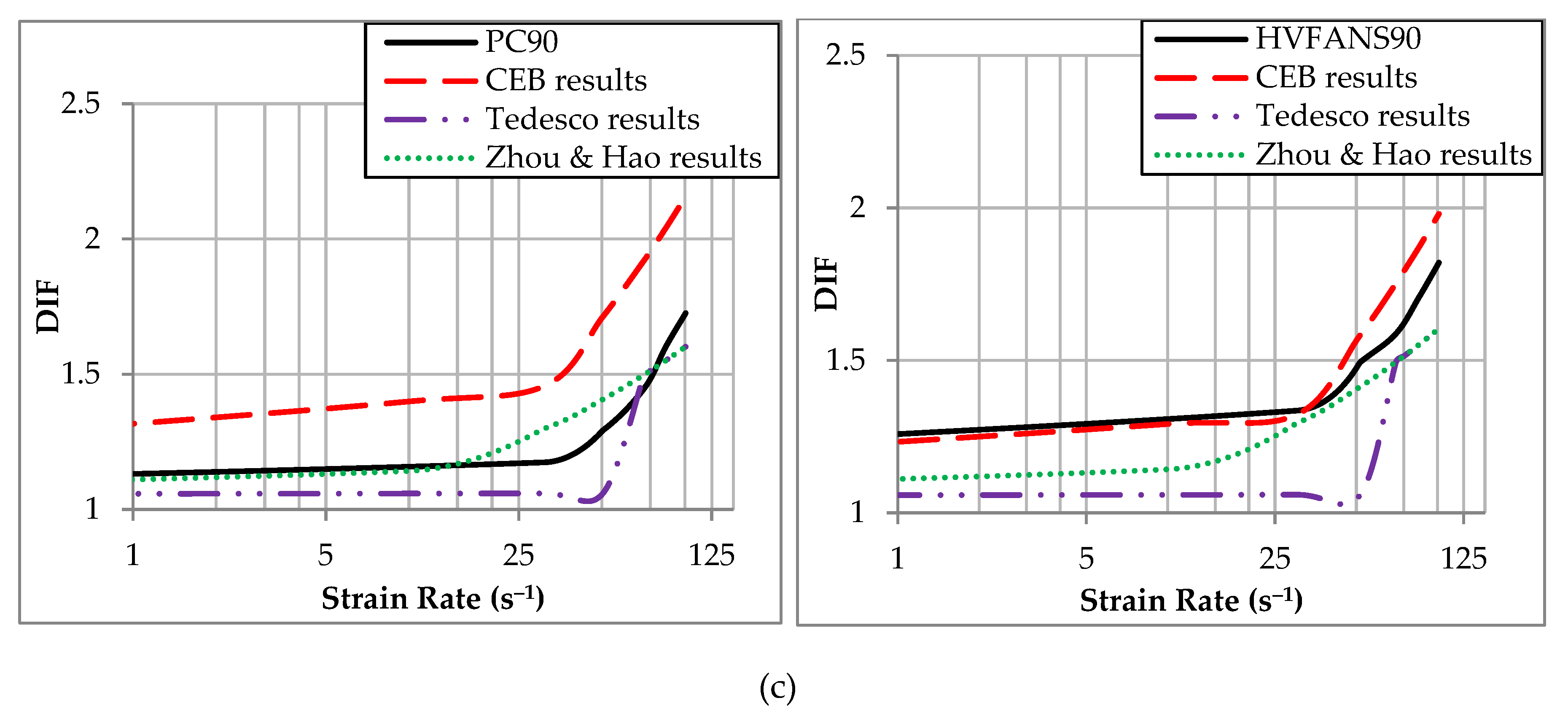
| Samples | Cement | Sand | Gravel | Water | Fly Ash | Nano-Silica | PPF % |
|---|---|---|---|---|---|---|---|
| PC | 531.30 | 780.06 | 942.64 | 170.16 | - | - | 1 |
| HVFANS | 225.80 | 682.01 | 942.64 | 154.85 | 278.93 | 26.56 | 1 |
| Sample No. | Time (days) | |||||
|---|---|---|---|---|---|---|
| 7 | 28 | 90 | ||||
| PC | HVFANS | PC | HVFANS | PC | HVFANS | |
| 1 | 50.81 | 49.12 | 61.82 | 57.95 | 61.48 | 67.82 |
| 2 | 49.62 | 45.34 | 62.66 | 61.55 | 66.86 | 66.54 |
| 3 | 51.74 | 47.91 | 59.08 | 56.68 | 65.72 | 64.06 |
| Average (MPa) | 50.72 | 47.46 | 61.19 | 58.72 | 64.69 | 66.14 |
| Maximum relative error (%) | 2.17 | 4.47 | 3.45 | 4.82 | 4.96 | 3.14 |
| Sample No. | Time (days) | |||||
|---|---|---|---|---|---|---|
| 7 | 28 | 90 | ||||
| PC | HVFANS | PC | HVFANS | PC | HVFANS | |
| 1 | 42.31 | 44.37 | 58.61 | 67.79 | 59.67 | 64.81 |
| 2 | 40.48 | 41.81 | 56.48 | 61.01 | 62.31 | 67.12 |
| 3 | 43.13 | 43.50 | 59.48 | 64.86 | 61.15 | 65.60 |
| Average (MPa) | 41.97 | 43.23 | 58.19 | 64.55 | 61.04 | 65.84 |
| Maximum relative error (%) | 3.55 | 3.28 | 2.94 | 5.48 | 2.24 | 1.94 |
| Sample No. | Time (days) | |||||
|---|---|---|---|---|---|---|
| 7 | 28 | 90 | ||||
| PC | HVFANS | PC | HVFANS | PC | HVFANS | |
| 1 | 28.91 | 40.14 | 38.87 | 51.6 | 39.81 | 53.12 |
| 2 | 30.68 | 38.50 | 33.54 | 52.13 | 37.11 | 50.44 |
| 3 | 27.22 | 37.77 | 36.71 | 46.26 | 35.81 | 49.91 |
| Average (MPa) | 28.94 | 38.80 | 36.37 | 49.99 | 37.58 | 51.16 |
| Maximum relative error (%) | 5.94 | 3.45 | 7.78 | 7.46 | 5.93 | 3.83 |
| Concrete | Temperature ( °C) | Curing Age (days) | Average Strain Rate (s−1) | Dynamic Compressive Strength (MPa) | ||||||||
|---|---|---|---|---|---|---|---|---|---|---|---|---|
| C1 | C2 | C3 | C4 | C5 | C1 | C2 | C3 | C4 | C5 | |||
| PC | 25 | 7 | 31.64 | 51.55 | 70.78 | 86.12 | 100.44 | 65.77 | 71.32 | 76.9 | 82.42 | 89.56 |
| 28 | 30.12 | 50.72 | 71.32 | 85.24 | 101.42 | 73.39 | 81.25 | 88.66 | 98.61 | 113.77 | ||
| 90 | 30.88 | 51.56 | 71.77 | 85.66 | 100.17 | 79.88 | 87.61 | 96.23 | 105.33 | 123.6 | ||
| HVFANS | 25 | 7 | 30.82 | 51.18 | 70.92 | 85.11 | 101.15 | 59.89 | 64.11 | 67.77 | 74.16 | 80.12 |
| 28 | 30.49 | 50.38 | 71.22 | 85.89 | 100.91 | 70.68 | 79.2 | 86.63 | 94.18 | 108.82 | ||
| 90 | 30.71 | 50.11 | 70.65 | 85.28 | 100.83 | 83.11 | 91.23 | 100.65 | 111.24 | 127.87 | ||
| PC | 400 | 7 | 31.45 | 51.22 | 71.44 | 85.77 | 101.24 | 48.43 | 55.12 | 60.12 | 67.88 | 73.15 |
| 28 | 31.02 | 50.35 | 70.61 | 86.17 | 100.26 | 68.69 | 77.86 | 85.14 | 93.39 | 97.46 | ||
| 90 | 30.19 | 50.8 | 71.23 | 85.59 | 101.61 | 73.11 | 80.88 | 87.95 | 98.11 | 113.2 | ||
| HVFANS | 400 | 7 | 31.33 | 51.64 | 70.47 | 86.18 | 100.12 | 52.13 | 58.2 | 64.87 | 71.23 | 76.79 |
| 28 | 30.84 | 50.91 | 70.83 | 85.3 | 100.67 | 77.73 | 85.8 | 93.38 | 102.82 | 119.43 | ||
| 90 | 30.37 | 50.13 | 70.76 | 86.81 | 100.61 | 81.76 | 90.16 | 99.31 | 110.98 | 127.11 | ||
| PC | 700 | 7 | 30.44 | 51.25 | 70.1 | 86.34 | 102.48 | 31.2 | 33.52 | 36.66 | 41.12 | 43.78 |
| 28 | 30.64 | 50.83 | 70.17 | 85.68 | 100.81 | 42.86 | 47.18 | 52.39 | 57.72 | 61.77 | ||
| 90 | 31.02 | 50.43 | 71.24 | 85.12 | 100.57 | 44.13 | 48.58 | 54.43 | 60.15 | 64.86 | ||
| HVFANS | 700 | 7 | 30.09 | 50.16 | 70.66 | 85.91 | 101.45 | 44.12 | 52.78 | 57.9 | 64.76 | 69.83 |
| 28 | 30.78 | 50.69 | 70.42 | 85.17 | 100.54 | 64.88 | 70.3 | 73.28 | 80.31 | 84.43 | ||
| 90 | 30.17 | 51.76 | 70.21 | 85.61 | 101.26 | 68.31 | 76.45 | 81.22 | 87.4 | 93.13 | ||
| Concrete Type | Transformation | Model | R2 | Adjusted R2 | Predicted R2 | AP |
|---|---|---|---|---|---|---|
| PC | inverse | 2FI | 0.9534 | 0.9460 | 0.9341 | 36.9194 |
| HVFANS | Inverse | 2FI | 0.9557 | 0.9487 | 0.9283 | 35.9574 |
© 2020 by the authors. Licensee MDPI, Basel, Switzerland. This article is an open access article distributed under the terms and conditions of the Creative Commons Attribution (CC BY) license (http://creativecommons.org/licenses/by/4.0/).
Share and Cite
Mussa, M.H.; Abdulhadi, A.M.; Abbood, I.S.; Mutalib, A.A.; Yaseen, Z.M. Late Age Dynamic Strength of High-Volume Fly Ash Concrete with Nano-Silica and Polypropylene Fibres. Crystals 2020, 10, 243. https://doi.org/10.3390/cryst10040243
Mussa MH, Abdulhadi AM, Abbood IS, Mutalib AA, Yaseen ZM. Late Age Dynamic Strength of High-Volume Fly Ash Concrete with Nano-Silica and Polypropylene Fibres. Crystals. 2020; 10(4):243. https://doi.org/10.3390/cryst10040243
Chicago/Turabian StyleMussa, Mohamed H., Ahmed M. Abdulhadi, Imad Shakir Abbood, Azrul A. Mutalib, and Zaher Mundher Yaseen. 2020. "Late Age Dynamic Strength of High-Volume Fly Ash Concrete with Nano-Silica and Polypropylene Fibres" Crystals 10, no. 4: 243. https://doi.org/10.3390/cryst10040243
APA StyleMussa, M. H., Abdulhadi, A. M., Abbood, I. S., Mutalib, A. A., & Yaseen, Z. M. (2020). Late Age Dynamic Strength of High-Volume Fly Ash Concrete with Nano-Silica and Polypropylene Fibres. Crystals, 10(4), 243. https://doi.org/10.3390/cryst10040243








